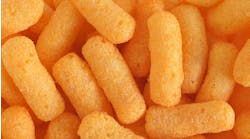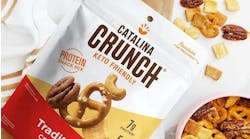The "ketogenic diet" is arguably the hottest current diet fad in America. Its celebrity adherents include LeBron James and the Kardashians. According to one estimate cited by Kerry Group, the market will grow by 5.5% a year to reach $15.6 billion by 2027.
But the keto diet's unique mix of more fat and less carbohydrate creates certain processing challenges.
In 2019, “keto” was the most widely discussed diet trend on Reddit, while “keto pancakes” and “keto cheesecake” were the fourth- and fifth-most searched food terms on Google in 2018.
“And for January through July 2020, we have already reported 76% of 2019’s full year total of ‘keto’ or ‘ketogenic’ snack products, so there is an excellent chance that we will top 2019’s full year numbers this year,” says Tom Vierhile, vice president for strategic insights-North America at Innova Market Insights.
The concept is drawing interest from mainstream processors: In September, General Mills rolled out “:ratio,” a “keto-friendly” line of snack bars and “yogurt-cultured dairy snacks.”
The keto diet may be a star, but what is it, exactly?
It shares certain characteristics with other formerly hot diets, like Atkins and paleo: an aversion to carbohydrates and an emphasis on protein. But it has some significant differences; the biggest is probably its welcoming of fat as a replacement for carbs.
The keto diet actually has a long history. It was started in the 1920s as a way to treat epilepsy by reducing brain inflammation. It derives its name from “ketosis,” the process by which the body breaks down stored fat into molecules called “ketone bodies.” This happens when blood glucose, the body’s first choice for energy, runs low; cutting down on carbs is a way to make that happen.
Read more about the Keto Diet and how processors are formulating with fats at:
Favorite Fats of the Keto Diet
“Generally, our cells prefer to use glucose for energy, but when carbohydrate intake is low the circulating blood glucose level becomes greatly decreased,” says Nancy Farrell Allen, a spokesperson for the Academy of Nutrition and Dietetics. “Our body then turns to the process of ketosis for its source of energy.”
This food molder, often used to shape ground meat, is a also suitable for keto-type dough or batter. Photo: EnSight Solutions
The attraction seems to be in pairing the loss of carbs, which are also demonized under the Atkins and paleo diets, with a more permissive attitude toward fats, at least certain kinds. Like most diets, most of the people who follow them have losing weight as a priority, although Farrell Allen cautions, “While most persons initiate a diet like this for quick weight loss results, compared to other heart-healthy diets, the difference in weight loss on a keto diet disappears over time.”
Processing challenges
No matter how effective the keto diet is or isn’t at helping individuals reach their goals, keto-friendly snacks present processing challenges.
“Keto is high fat, low starch and moderate protein,” says Gary Seiffer, sales specialist for EnSight Solutions. “Protein is a binder in the cooking process, as the starch can be, to help hold the product’s shape. So when fat is a major ingredient, not only is proper mixing and forming critical, but then down-line processing is very important too.”
One of the biggest challenges with keto formulations is the lack of carbohydrate, which translates to a formulation with little or no starch. However good or bad starch may be from a dietary standpoint, it’s an easy component to process into snacks, because it expands and holds its shape, especially when it’s exposed to a sudden drop in air pressure coming out of an extruder.
That drop in pressure decreases the boiling point of the moisture in the formulation, causing it to flash off and leaving the dough with a void-filled structure that translates to an airy texture when fried. But that’s not possible with formulations for keto snacks, which tend to be high in protein and fat.
Twin-screw extruders are a better option than single-screw for keto formulations. Photo: Clextral
“The high fat content of keto recipes leads to less expansion so the snacks often have more density in texture compared to traditional cereal-based snacks,” says Hadrien Delemazure, an extrusion process expert for Clextral.
Protein is 10-20 times denser than carbohydrates, which requires more pressure to process in an extruder, increasing the process temperature. That has implications for the fat, which tends to melt under heat and pressure. Water is also harder to remove from fat and protein than from starch.
For these reasons, and others, keto-style snacks are harder to mold than traditional snacks, and usually can’t be formed into unique shapes.
“Keto snacks are usually made in basic shapes because the texturization of the proteins tends to produce random and unique surface appearances – which can be interesting and desirable product attributes for snack manufacturers,” Delemazure says. Twin-screw extruders are good options for the high-fat, high-protein formulations in keto, he says.
But the molding issues are why Seiffer doesn’t think extrusion is a good choice for keto-style formulations. “Extruding is all about pressure,” he says. “Extruding tends to raise product temperature. Fat melts when warm. The starches may not have the opportunity to be cooked to a point that holds shape, and the moderate protein may not yet have a chance to coagulate to hold shape.”
In addition, many keto snack formulations are gluten-free, giving them the consistency of pancake or muffin batter; this would require a depositor that uses a pump or gravity.
The high fat content of a keto snack can create other problems. For instance, pork rinds and cracklings are usually cooked in lard, which presents certain challenges because its relatively high melting point makes it solidify at room temperature. That makes it harder to clean fryer kettles and ancillary equipment like return pipes, manifolds and filters, says Adam Holloway, regional sales manager for TNA North America.
“Adjustments may also need to be made to the frying process,” Holloway says. “Unlike traditional snack products, which absorb oil during cooking, pork rind pellets produce oil as they expand. This means that provision must be made for oil to be removed from the fryer to maintain optimum oil levels, instead of adding it back in, as with potato chips.”
More science than art
Processors of keto snacks face these difficulties from the get-go.
“As you take away sugar and many binders, fillers and flours that give sweets and treats their flavor and texture, it becomes more difficult and costly to replace those,” says Hector Patrick, CMO of Bett3r Keto (picture above), which produces a full line of keto products including cookies and chocolate bars.
“Especially with baking, which is more of a science than an art, it’s very difficult to get to a flavor profile and taste when you have to work without most traditional fats and sugars that are found in traditional baking,” Patrick says. “On top of that, you throw in making products ‘shippable,’ which at its core is very difficult to begin with.”
The problem is especially acute for snacks such as cookies, that traditionally have a crisp surface.
Keeping Sheila G’s Brownie Brittle crisp wasn’t easy due to the high fat content.
“We have been handcuffed at times, having to scale back ... because of a lack of scalability on the manufacturing and logistics end,” Patrick says. “We’ve had issues anywhere from broken cookies to cookies that cannot stay fresh longer than a month.”
The difficulty involved means that when processors find the solution, they want to keep it close to the vest.
“I’d rather not go into details of our manufacturing process, as our keto item is very unique to the market because it is keto approved while keeping a crisp texture—difficult to achieve due to the high fat content,” says Ashley Dawkins, vice president of marketing for Sheila G’s Brownie Brittle. Smaller manufacturers of keto snacks often have to use contract manufacturers, but they’re no panacea. Patrick says it took a year and half of trying and failing, but “we believe we have finally found the right team that can keep our ‘small batch feel’ and ‘hands-on approach’ to formulation and R&D, yet provide consistency and scalability at a reasonable price.”
Keto snacks are in demand because they provide indulgence that can be hard to come by on the keto diet, with its avoidance of sugar and any other form of carbs. Mastering the difficulties of their formulation and processing could be a key to profitability.


